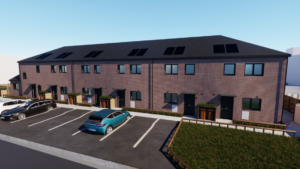Why are ‘posh ghost towers’ still being built?
 Anger is growing over the number of ‘post ghost towers’ given planning permission in London while thousands lack affordable housing. Tony Hutchinson assesses the logic.
Anger is growing over the number of ‘post ghost towers’ given planning permission in London while thousands lack affordable housing. Tony Hutchinson assesses the logic.
In a city where every inch of land is precious and for which there are multiple competing uses, the development of homes that won’t be lived in and are only affordable to the super rich seems perverse.
There is justifiable anger that local councils in the capital seem to allow these ‘posh ghost towers’ through planning with little challenge. This is despite in many cases the schemes fail to comply with local planning policy especially in terms of sub-market, affordable homes.
These are largely towers, not that towers are necessarily wrong, but towers with facilities like a high grade hotel and service charges to match, that do little to meet the needs of the people who make the city work. The people who work in transport, catering, health, retail and public services: whose wages fail to keep up with rents or house prices.
Once high rise living was a response to slum clearance and towers were built by councils to meet the housing shortages of the 50s and 60s. Even then it was recognised that building high carried extra costs and that the subsidy system rewarded ambition to build high. What was not recognised or taken fully into account were the additional costs that flow from building high. The consequences of this are starkly apparent.
‘Developers build ghost towers because they can, and
because planning is so heavily weighted in their favour’
So why are these modern towers being built?
Land prices in London are so astronomic that high density development is needed to recover the land cost, but the economics of construction mean that high sales values are needed to balance the books.
Thus, if someone is paying £1m for a property, not only does the specification need to be high but also the amenities around the property need to reflect the price tag. Then the sales rate of high cost properties is assumed to be slower than cheaper homes. All these factors add to the project costs, before developer’s profit is added on top.
Profit is essential if projects are going to be delivered; it is the reward for the risk borne by the developer. These costs are set out in a development appraisal, prepared by a reputable, well qualified and respected firm of chartered surveyors. The developer submits this as part of the planning process. The goal of this appraisal is to show that the development proposed cannot provide new affordable homes or contributions to schools, public realm improvements or any of the other things required to mitigate the adverse consequences of a development.
When the council gets this appraisal it has to be considered as part of the planning process, often using another reputable, well qualified and respected firm of chartered surveyors. Who are, perhaps, working for a council this week and who will next week be working for a builder. This process is commercially confidential as the two firms negotiate what is the most credible set of assumptions for the appraisal. And therefore the costs, revenues, profits and crucially contributions to Section 106 and the Community Infrastructure Levy. A central goal is to negotiate away any affordable housing contribution.
As planning consent should only be given for a deliverable scheme, the council must take into account the viability of the scheme when considering it. Refusal means that the developer will appeal and this is a cost factored in to the development but not into council budgets. Contesting an appeal consumes huge quantities of officer time and sucks in swathes of expensive professional advice.
Incidentally the high cost of services in a new tower means that it is hard to let them as social or affordable housing, as housing benefit will not cover the costs of eligible items and many of the items are not eligible for benefit.
Perhaps the answer is that developers build ghost towers because they can, and because the planning process is so heavily weighted in their favour that local councils simply cannot challenge them.
Making the viability assessment process totally transparent is a necessary first step in challenging the hegemony of the big developers with their deep pockets and political connections.
The process of appealing against a planning decision needs to made equitable between councils and communities contesting the desires of building behemoths. Where large scale projects are planned, there is an argument for greater critical debate over height and density.
Are there better solutions to achieving the number of homes needed than these towers, with their higher construction costs, longer development cycles and greater revenue costs?















